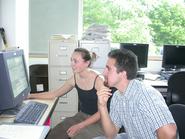
Four Hamilton students, Meghan Dunn '06 (Clinton, N.Y.), Pragyan Pradhan '08 (Lalitpur), James McConnell '07 (East Setauket, N.Y.) and Ngoda Manongi '08 (Roxbury, Mass.), will be working together on a chemistry research project on both terrestrial and exotic atmospheric chemistry. They hope to determine the structure, the levels of heat given off during a given reaction, and kinetics of certain molecules in different atmospheres, including the atmosphere of Mars and Venus. The students will work with Winslow Professor of Chemistry George Shields and Visiting Assistant Professor of Chemistry Karl Kirschner on the project titled "Atmospheric Chemistry: Predicting structure, energy, reactivity, frequency and abundance of atmospheric species clustered with water."
As a four-year summer science researching veteran, Meghan Dunn '06 is the group leader. According to Dunn, the group is currently investigating the hydroxyl radical (OH) clustered with water. "The hydroxyl radical is among the most reactive species in the atmosphere, and is responsible for reacting away many organic pollutants," she explains.
Using computational chemistry and advanced computer technology, the group will predict the structures of atmospherically important species as well as the energies of the clusters to predict their abundance in various atmospheres. "Taking reactivity and abundance into account, we calculate vibrational spectra, which assist spectroscopists in where to look for these compounds in the atmosphere," Dunn explains. These compounds then will help clear the air of organic pollutants like car emissions and industrial use of solvents.
Although the group is working together on the same project, various group members have different research responsibilities. For example, Manongi is researching possible conformations of N2-H2O clusters and exploring the atmosphere of Mars; Pradhan, exotic atmospheres: study on the atmospheres of other planets, with focus on Venus, while researching (H2O)n.O2 clusters.
Despite a cohesive group dynamic, the group has found some elements of their research to be difficult. "Computational chemistry can be tricky. We submit jobs to computers and they can be tricky. Either they crash or the type of calculation we perform is not accurate, so there is a lot of trouble-shooting," Dunn explained.
Other than the occasional computer malfunction, however, the group anticipates having great success in the lab this summer.
-- by Emily Lemanczyk '05
Posted June 21, 2005
